Account Based Marketing in 2024: Increase B2B conversions
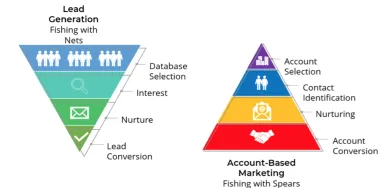
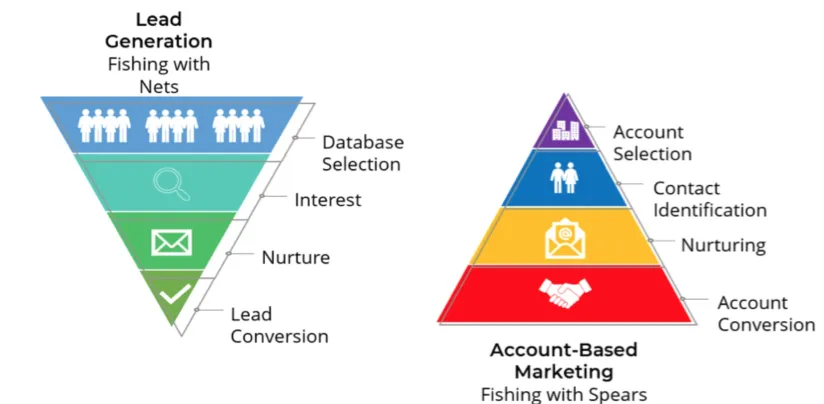
Increasing volume of sales does not always mean a profitable business due to the high cost of sales. For a lead to be profitable, the value of lead should be higher than the cost of sales. The problem is that organizations don’t have a clue about which leads are profitable. Account-based marketing enables organizations to identify which accounts are more likely to convert so that organizations’ marketing and sales reps can focus on only those accounts.
What is Account-Based Marketing (ABM)?
Account-based marketing is a highly customized, data-driven B2B marketing approach that targets high-value accounts and delivers messages according to specific attributes and needs of accounts. Account-based marketing aims to deal with the typical challenges of B2B such as:
- the difficulty of identifying accounts well suited to your product
- shortening sales duration
Why is it important now?
According to a survey conducted by Demand Metric, 96% of participants believe that ABM is the key driver to increase revenue in B2B sales. With ABM, organizations can adjust their marketing budgets according to customers’ likelihood to buy so that organizations can increase the quality of marketing for customers who are more likely to convert. In the meantime, competitors’ marketing budget is the same for each account that’s why the experience quality an ABM using company offers to its leads is much higher than its competitors. The graph below highlights the competitive advantage of organizations with the ABM system.
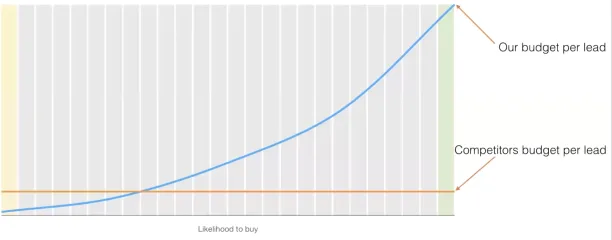
How does it work?
Targeting
- Discover high-value accounts: Find accounts that have the most potential to contribute to the revenue of your organization. Firmographic, technographic and intent data are used in account identifications. We explain these data in detail below.
- Identify who to reach. If you are targeting
- SMEs, this should be a mostly automated process with a focus on roles that are the important stakeholders during the purchase of your product. Your current sales results can guide which roles to target. For example, a chatbot company could be targeting Chief Revenue Officers (CROs) as explained by the Drift team
- Enterprises, the level of automation will vary based on your company’s product and approach. For high-cost products, a more manual approach could be chosen. Your team can do manual research to answer these questions: Who are the decision-makers of the account, what are the important criteria for them, how have they indicated an interest in our product?
- Select optimal channels: If your campaigns are not seen by target accounts, you will get no gains from ABM. Therefore you need to decide on which channels will be more effective to interact with accounts. You have various options such as email, the social networks as well as phone calls. For one-to-one messages, companies rely on email or LinkedIn.
Leading tools for targeting
Identifying accounts already visiting your digital properties
These companies identify who is visiting your website and what they are looking for so that you can profile every potential account. It provides you insights from website visits including company names, location, sector, website and other important contact information so you can outreach to these companies. Since it provides company level information rather than personal information, these companies claim to be GDPR compliant and process all visitors’ information, not just those that accept cookies.
Leadforensics, Leadberry, LeadLab, Pipedrive, SalesViewer, Snitcher, Zoominfo are vendors that offer this functionality.
Identifying leads within target accounts
Once target accounts are identified, numerous tools exist to identify leads within accounts. Using the typical employee profiles that buy your solution, you can identify target leads using Linkedin or tools such as ZoomInfo, Apollo.io or growbots.
Gathering information (intent, technographic, firmographic) about accounts
Datanyze provides target accounts’ technographic data so that organizations can gain insights about accounts’ tech buying habits, how they work, the challenges they face and what tech they’ll buy next. By leveraging tech stack information, organizations can understand how and when to launch their campaign. Datanyze information is also provided in ZoomInfo since ZoomInfo acquired Datanyze in 2018.
Bombora and G2 provide intent data to help companies identify accounts that are researching for solutions in their area of focus. While Bombora uses 3rd party websites’ data, G2 uses its own analytics data for this service.
Oracle’s DataFox claims to combine news about the company with technographic and firmographic data to profile and classify accounts. They provide these company-specific data points:
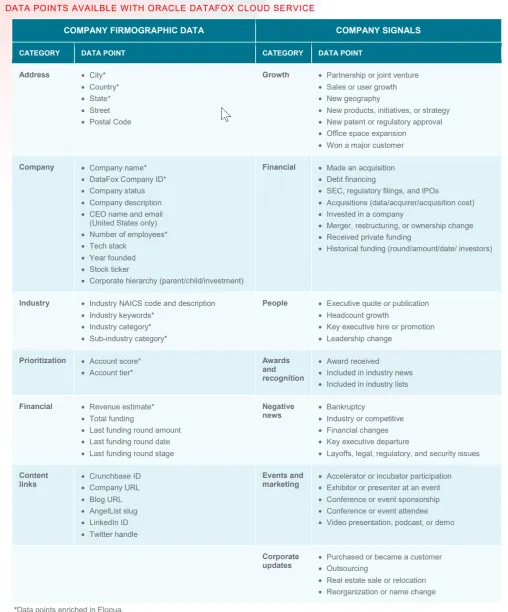
ZoomInfo provides a comprehensive set of features:
- Identifies accounts visiting your website
- Crawls the web for news/announcements about companies
- Provides department structure, personnel hierarchy, and contact information so companies can prioritize the right individuals to outreach. This data is based on their community edition outlook plugin which allows companies to access 10 leads per month. For this service, the plugin collects email signatures from the emails plugin users receive. Users whose contact information is collected are requested to opt-in in case they are in a jurisdiction with data privacy laws like GDPR or CCPA.
Clearbit helps you to get company attributes such as employee count, technologies used, and industry classification. It has an API for easy integration. It also has real-time sales alerts to make you prepared to reach the right people at the right time.
DueDil provides a similar solution and provides especially detailed data for UK companies thanks to its analysis of public Companies House data.
Engagement
- Create personalized messages&content: Personalization is the key to success when it comes to marketing. Effective content should address your customers’ needs and pain points in the industry.
- Launch your campaigns: You are ready to execute your campaign to target accounts. Make sure you are not delivering repetitive and conflicting messages to your target.
Leading tools for engagement
Adobe Marketo Engage leverages accounts behavioral data to create automated campaigns across channels. It assesses measurable metrics such as predictive content, A/B testing, and personalization to deliver consistent and relevant experiences throughout the customer journey to determine the best strategy to sell at each stage.
Terminus aims to deliver the right message to the right customer at the right time. Terminus uses their 50+ ad networks and 200 million data points to proactively engage the right people wherever they are online. They can also personalize your organization’s website and messaging using their insights.
Sparkpost is a cloud email delivery service that helps organizations optimize their email performance by providing personalized emails.
Measurement
- Analyze returns: After you launched your campaign, collecting data about the results of messages is also important. Decide on whether your messages are effective or there are improvement areas to work on.
Leading tools for measurement
Ambition is a sales performance software that combines metrics from different data sources like Salesforce, Cisco and PeopleSoft. It performs analysis of sales data and provides dashboards and data visualization.
SalesLoft helps organizations understand what was successful in their recent campaigns by analyzing data. Organizations can determine whether they need to pivot their strategy or drive more adoption of winning plays.
How does data drive ABM?
ABM relies on real-time data to identify leads and to customize how companies communicate with those leads. Commonly used data include:
Company-level data
Firmographic data
This is the most general and easy-t0-access data of companies. All B2B companies rely on firmographics to prioritize accounts. This category includes key characteristics of the account that can be collected from its website as well as its social media profiles like Linkedin.
Data fields include industry, turnover, profitability, number of employees, organization chart, monthly web traffic.
Technographic data
A company’s current use of technology is a good predictor of that company’s potential spending. For example, it is easier to sell a CRM to a company that does not have one compared to a company that has been using and customizing its CRM system for years.
Data fields include the systems used by the company in different areas such as CRM etc. Most of the data come from crawling the company’s website since web related tools (software to build the website, analyze the traffic, etc.) leave noticeable traces on the website. Additional data comes from the company’s procurement portal.
Intent data
The most important data in our humble opinion since this helps identify in-market companies looking for solutions in your target market. Even the most suitable customer for your product will not pay attention to your product if they are facing an urgency. Understanding what is on your potential customers’ minds is the most important data point.
Data fields include: web pages visited by the company’s employees, announcements by the procurement team, etc. Most companies that offer intent data use these inputs to feed their machine learning models and provide specific intent topics per company.
ZoomInfo offers one more step on top of the intent data. They claim to have an in-house team calling companies to identify relevant projects which they call Scoops.
Signals: Company events
Sometimes this category is merged into intent but they are slightly different. While the intent is what the company is searching for, signals can also include what is happening at the company. These include hires and promotions, new initiatives, acquisitions, divestitures, new tech developments within the company’s industry, new investments, etc.
This includes data that is higher in the funnel but can help customize how you can reach out to a company. For example, recent promotions in areas where your company can add value can be good opportunities to introduce your company’s products and services to employees who are looking for new performance improvement initiatives.
Lead (individual) level data
This is commonly used to identify who to reach in the identified accounts.
Data fields include: Contact details (email, phone, social media accounts including LinkedIn), role, time in the role and additional information such as career history and education which can help companies customize their messages.
How is ABM different than CRM?
ABM software is mostly a tool that can be integrated into CRM solutions. CRM focuses on leads (individuals) while ABM is focusing on accounts (companies). For example, ABM helps you discover new accounts and if your outreach to new accounts is successful, then those leads should be tracked in your CRM system. CRM can help your ABM strategies by showing which accounts generate the most impact and help focus your ABM efforts.
What are example case studies?
CloudCherry
Challenge: CloudCherry wanted to build a better buyer journey, they knew it should start from the beginning that means attracting customers for their brand with marketing.
Solution: CloudCherry aimed to understand their customers better by answering questions such as
- Who are the leaders in customers’ organizations?
- When they are looking to buy?
- How they research?
- What tech and tools are they using?
They used Salesforces Pardot to score accounts to identify high-value accounts. Then they collected intent data from G2 to see which accounts are looking for their or competitors’ technology. After that, they extracted the list to DiscoverOrg so that they can see all the technographic data these accounts have. They also integrate this list to Demandbase to get additional information about keywords employees of the account search when they look for a product and then delivers all the information they got to sales reps to create relevant campaigns.
Results: CloudCherry tripled its pipeline and experienced a lifetime ROI of 266%.
Phononic
Challenge: Building credibility with their audience. Phononic needed to prove to target accounts that their technology was different and better.
Solution: Phonic started to use Terminus ABM software. With ABM, they aligned marketing and sales teams which means both teams spent their resources for the same accounts collaboratively. Daniel Englebretson, director of integrated marketing at Phonic, explains this alignment as “Now, it’s easier to say, ‘These are the accounts you wanted me to target, these are the departments at each account you wanted me to target, and here’s how they’re engaging.” The marketing team is working with sales to target the right accounts and showing how to engage those accounts with a relevant message to the sales team.
Results:
- Average sales cycles are reduced from 9 months to 1 month.
- Web visits from high-value accounts went up 78 percent.
- Boosted their sales email and call response rate
Engagio
Challenge: Engagio was struggling to identify and message target accounts by only using demographic and firmographic data before using Datanyze software.
Solution: With Datanyze, Engagio was able to analyze technographic data that provides real-time insights based on a company’s technology choices and buying signals. Engagio first looked at their existing customers and technology stack that these customers have so that they identified their ideal customer profile and criteria for evaluating future accounts.
Results: Leveraging technographics enabled sales reps to have a better and more educated conversation with account decision-makers because reps knew what technologies are required for the account. It also helps Engagio find ideal accounts faster and increase engagement.
What are the benefits of ABM?
- Increased ROI: According to the 2018 ABM Benchmark Study, 77% of participants encounter a 10% or more return on investment (ROI) from their ABM programs compared to other traditional marketing strategies. It had an even bigger impact on 45%. They stated that ROI had more than doubled.
- Shorter Sales Cycle: The most time-consuming part of the sales cycle is handling the leads that are less likely to turn in to customers. Since ABM enables organizations to target specific accounts, sales team doesn’t deal with this as often.
- Less Waste Resources: Focusing on a small number of accounts frees up resources that would have been wasted with traditional marketing.
- Alignment of Sales and Marketing: With ABM, the sales team spends more time on a qualified, targeted lead rather than wasting time on unqualified leads. Alignment also helps the organization generate higher revenue, increase brand awareness and average deal size.
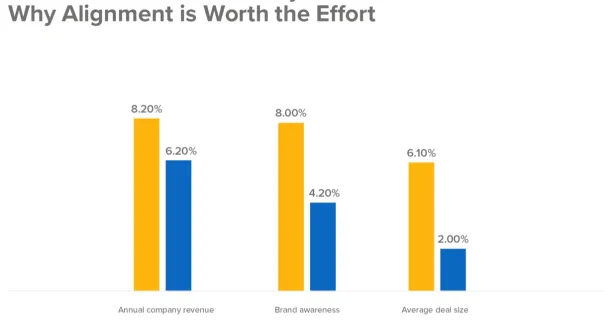
How does AI contribute to ABM?
ABM can be improved with the help of machine learning/AI. Both AI and ABM are heavily dependent on data. With AI-powered ABM, organizations can crawl numerous data sources to find information that’s useful for customer profiling such as what prospects are researching and which areas they are looking to invest in.
Identifying accounts to prioritize
Machine learning algorithms can be used to analyze account-level data such as intent, close/won percentages, campaign success metrics, etc. Such an analysis can help identify key account characteristics for success, find similar accounts or suggest the approaches that work better in sales such as personalized outreach.
Sending more timely, customized messages
According to a study, odds of contacting and qualifying a lead drops by 90% after 1 hour of receiving an email. With AI, organizations can automate customization of e-mail responses so that they can generate leads with dynamic emails. The image below shows a simplified example where fields in an automated email are auto-filled in a personalized way to send timely responses.
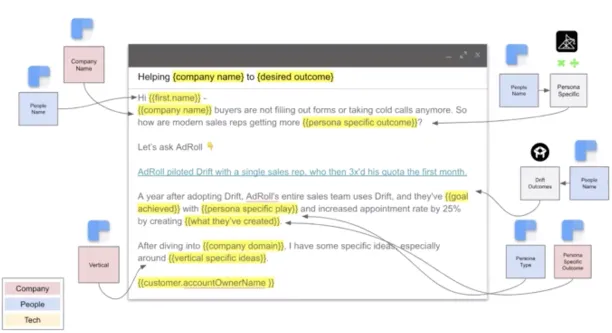
Step-by-step guide to starting ABM
If we were consultants chasing billable time, we would start the steps with organization, culture, etc. They are important but also obvious. We will focus on specific steps you can take and prioritize them according to cost/benefit. This is geared towards a small or mid-market company focusing on online sales:
Understand and reach out to your visitors
Any marketer tracks the conversion rate but a single number is not enough to understand why users are not converting. Seeing the companies that visit your website, as well as the characteristics of those that do convert, can help marketers:
- identify high priority segments
- reach out to companies that visit your digital properties but don’t convert, to understand the reasons behind this and convert them to leads if possible
- optimize your digital properties for conversion
Integrate more data in your CRM to support your sales team
Though this will definitely help sales reps improve their communication with potential clients, it needs to be coupled with coaching to ensure that your sales reps are using all the available data as they sell your solutions.
Use account data to generate leads
Intent data combined with firmographic, technographic and lead level information can be used to create compelling, well timed messages to the right individuals who are not yet aware of your companies services
Optimize the sales and marketing processes
Now that you are doing the basics of ABM, it is time to increase the level of automation and optimize initiatives based on their level of success. This needs to be a company-specific approach. For example, mature B2B companies that sell to SMEs will benefit significantly from automation while B2B companies targeting enterprises are likely to gain more value via training their sales reps and improving the sales process with data-driven insights gathered by ABM tools.
While automation will surely become more important in enterprise sales as well, enterprise customers, used to a high touch sales approach, are still less receptive to automated messages. However, automation can be used to augment sales reps. Partially auto-preparing a personalized pitch deck saves sales reps time and can impress enterprise customers.
What are the leading tools?
- 6Sense
- ActiveDemand
- Apollo
- Bombora
- Bound
- Datanyze
- Demandbase
- Engagio
- Groove
- HubSpot
- InsideView
- Leadfeeder
- LeadForensics
- LeadGenius
- LeadLab
- Marketo
- Nudge
- Terminus
- Triblio
- Salesviewer
- Vainu
- ZoomInfo
- Zymplify
Further Reading
If you want to learn more about marketing strategies, we recommend you to read our articles:
- Marketing analytics with AI: Complete guide
- Boost conversion with website personalization
- Artificial Intelligence Marketing: In-depth Guide
If you still have questions about account-based marketing, we would like to help:

Cem has been the principal analyst at AIMultiple since 2017. AIMultiple informs hundreds of thousands of businesses (as per similarWeb) including 60% of Fortune 500 every month.
Cem's work has been cited by leading global publications including Business Insider, Forbes, Washington Post, global firms like Deloitte, HPE, NGOs like World Economic Forum and supranational organizations like European Commission. You can see more reputable companies and media that referenced AIMultiple.
Throughout his career, Cem served as a tech consultant, tech buyer and tech entrepreneur. He advised businesses on their enterprise software, automation, cloud, AI / ML and other technology related decisions at McKinsey & Company and Altman Solon for more than a decade. He also published a McKinsey report on digitalization.
He led technology strategy and procurement of a telco while reporting to the CEO. He has also led commercial growth of deep tech company Hypatos that reached a 7 digit annual recurring revenue and a 9 digit valuation from 0 within 2 years. Cem's work in Hypatos was covered by leading technology publications like TechCrunch and Business Insider.
Cem regularly speaks at international technology conferences. He graduated from Bogazici University as a computer engineer and holds an MBA from Columbia Business School.
To stay up-to-date on B2B tech & accelerate your enterprise:
Follow onNext to Read
Best 9 Account Based Marketing Tactics in 2024
3 Types of Account Based Marketing (ABM) Strategies in 2024
All too often we see sales and marketing alignment being non-existent, where departments are working against each other rather than working together in alignment. Yet, both teams have the same goal of providing valuable experiences to the buyer and ultimately closing deals. According to LinkedIn, 87% of sales and marketing leaders say collaboration between sales and marketing enables critical business growth.
Comments
Your email address will not be published. All fields are required.